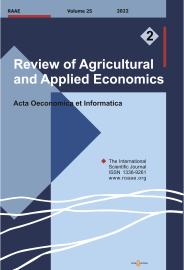KEYWORDS:
agricultural and RD policy evaluation, transition, policy targeting, EU enlargement
DOI NUMBER:
10.15414/raae.2012.15.02.29-38
ABSTRACT:
The paper provides an analysis of the effect of the EU membership on the agricultural and rural counties of Hungary, paying particular attention to the introduction of the CAP and Cohesion Policy. Moving from the mixed case study approach introduced for the evaluation of Rural Development policies, Hungarian rural areas are mapped using multivariate statistical methodologies (principal components analysis and cluster analysis) on a set of relevant variables periodically updated and available at a disaggregated level. Comparing the Hungarian rural counties in 2003 and 2007, a divergence between the expected objectives of the EU membership and the actual outcome emerges, with rural areas by far the worse off. Marginalization increased in lagging behind counties, such as Nógrád, confirming the presence of winning and losing regions as a result of the enlargement. Moreover, this study highlights the limits imposed by lacking national statistical sources on the quality of statistical analysis, and on the possibilities to undertake further evaluations of the EU accession experiences.
Please Cite this Article as:
MONASTEROLO, Irene (2012) Mapping Areas For Policy Evaluation: An Analysis Of Rural Hungary. Review of Agricultural and Applied Economics. XV (Number 2, 2012): 29-38. doi: 10.15414/raae.2012.15.02.29-38
URL for sharing:
https://roaae.org/1336-9261/doi/abs/10.15414/raae.2012.15.02.29-38
FULL TEXT PDF:
▼ direct download link| view online in fullscreen ▲

